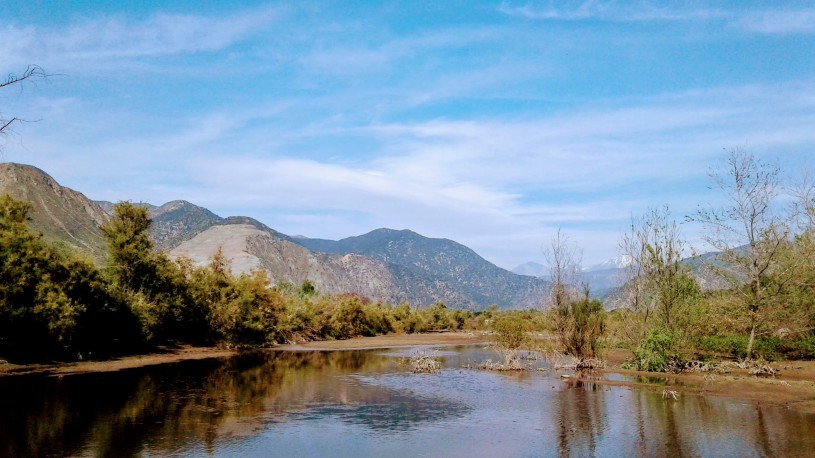The Hart Museum remains closed. Los Angeles County has approved a plan to transfer the William S. Hart Museum and Park from the County to the City of Santa Clarita.
Voices of L.A. Nature: An Interview with Brenda Kyle
Welcome to our new series, "Voices of L.A. Nature," where we'll hear stories from a diverse range of Angelenos about their relationships with nature in L.A.

This month, we're celebrating Hispanic heritage month, with two interviews from the community. Stay tuned throughout the year, for more Voices of L.A. Nature!
Brenda Kyle is a local naturalist who leads environmental programs all over the L.A. area. She rates herself an 11/10 on the, "I love nature scale!" Brenda is deeply connected to the mountains here in L.A., and is descended from the Tarahumara and Tepehuan peoples from Mexico. Keep reading to find out more about her relationship to, and adventures through the amazing nature of L.A.!

Can you share a memory of where and how you played as a kid?
Summers were spent at my grandmother’s house in the mountains of Durango. That’s the only place I remember playing. I was barefoot and outdoors, hair messy, and super tan skin. There were no clocks, no electricity, no running water, and no worries. My grandmother would buy us some Ritz crackers, a can of sardines in tomato sauce, and a bottle of Jarritos. That was our lunch. We’d spend the whole day playing in the arroyo. As we got older, play-time turned into washing-the-clothes-on-a-rock-time. That was less fun.
Can you tell us about when you moved to Los Angeles?
Our first home in L.A. was near the corner of Berendo and 11th Street. I remember a tree in the front yard and a small strip of grass on the side, but not much other greenery. I remember how to get to the grocery store and my mom would take us walking all through the area. I remember the panaderia had a pink, soft drink vending machine, and the floor had the typical honeycomb tile. I don’t recall any trees, or nature sounds. Not even a barking dog. There were only urban colors: drab concrete, worn asphalt, dreary wrought iron, and grey chain link.
We moved to the suburbs when I was 8. What a difference! We had a giant Chinese Elm in the front yard and the back fence was covered in a morning glory vine. There were horses across the street from the school. We had goats, chickens, and a dog! We didn’t have sidewalks and during the rainy season the streets would flood. I had never seen so much water in my life. There was a grove of California Black Walnut trees on the property in front and their wall was covered in passion fruit.

What nature places did you explore as a kid in L.A.?
As a kid, life was home, school, and then home again. My parents were not nature people. My dad worked 6 days a week and my mom worked 24/7 doing mom things. We would go to La Placita on Sundays. That’s where we went to church. It is also where I got my color fix and by extension my nature fix. The trees were majestic even then. The Aztec dancers wore bird feathers, deerskin and jaguar pelts. The folklorico dancers wore flowers in their hair. To me the ladies looked like giant flowers. When they spun around, their skirts would open up like blossoms in the sun.
Can you tell us a little bit about your career?
I am an L.A. Naturalist! Over the last few years, I've been able to work and volunteer on so many projects. My job as a naturalist is to get people to wonder about how things are connected. I focus a lot on plants because, like water, they are absolutely necessary for life. I connect people, place, and plants.
I currently work for the Theodore Payne Foundation as the Volunteer Coordinator. But I have lots of jobs and roles all over the region. In the past I worked for the San Gabriel Valley Conservation Corps, planting trees in County Supervisor District 1. I've built habitat along the Rio Hondo and the San Gabriel rivers, with Amigos de los Rios. I also, am currently a Grand Park Ranger leading excursions in this very urban park, and an instructor with Outward Bound Adventures. I also volunteer with San Gabriel Mountains Heritage Association, Nature for All Stewards, Los Angeles Sheriff’s Department, and at the Eaton Canyon Nature Center.
How do you incorporate nature into your daily life?
Firstly, I get to work in a beautiful canyon at the Theodore Payne Foundation. Our nursery attracts all kinds of insects, birds, reptiles, and mammals. Then there are the plants! The scent of all the sages are what I love experiencing every day. When I'm not at work, I relax by going into the mountains or listening to the river. Even my volunteer work involves nature. When I'm volunteering for the Sheriff's department I usually work the outer perimeter on the mountainside, during local fires or mudslides.

What is your favorite nature space to visit in L.A.? What do you do there, and why do you go?
When I think of L.A. I don’t think just of the city limits, I think of the whole of Los Angeles County. I live in the suburbs, the mountains are walking distance, as are two rivers. We have desert and beaches nearby, too. But, my favorite place will always be the mountains. My mom picked our current home because it reminded her of my grandmother’s house. Mountains on one side, and a river within walking distance. We are of Tarahumara and Tepehuan descent. Tepehuan is the Nahuatl word for “mountain dweller.” We are definitely a mountain people. Rarumari means “the moon is the sunshine of the night”. Full Moon walks in the canyon are where I feel the most connected to nature and to my ancestry.
What is your favorite plant/animal/fungus/slime mold/other organism in Los Angeles?
Mulefat. I love mulefat. The scent reminds me of my grandmother and the arroyo. She called it huatamote. Her Spanish was very Mexican. I can still hear her singsong voice say things like zocete, tecolote, huisache, azcel, tepocate, chimpas. My mom knows the plant as jarrillas.
Do you have a funny story about a nature experience you had in L.A.?
I was leading a moonlight walk in the canyon. I led our group up into the meadow. Imagine being surrounded by massive oak trees, with the mountains in the background and the moonlight bouncing off the silvery sage. It was shadow and light, and the air was sweet and balmy. Then, a little voice exclaims, “look daddy, a moose!” It was a deer, a beautiful tawny deer. It pranced off into the darkness between the oaks and the mountainside. Everyone laughed, and before anyone dared to correct her, I just asked, “wasn’t that amazing?” I hope her dad never told her it wasn’t a moose. She should discover that on her own.

The recent Atlantic article, Five Ways to Make the Outdoors More Inclusive, laid out some concrete steps that National Parks and public lands can employ to become more inclusive. What do you think about the process, the team, and the recommendations?
I’ve met many of the contributors and I respect them all. I could hear their voices as I read the article. However, the first item: hire historians. That didn’t sit too well with me. I agree that storytelling is a powerful tool, but who gets to tell the story? Who gets to decide what is valuable? I was at a Forest Service event where a woman was introduced as, “she probably knows more about the Indians than the Indians know about themselves”. This is utter rubbish, and NOT okay. She was very knowledgeable, but where did that knowledge come from? The Indians. California has close to 200 known indigenous cultures. Lumping everyone under a title like, "The Indians," is just as bad as saying, "Those People". Elizabeth Yeampierre of Uprose Brooklyn said it best when she said, “Oh, you want my story, but you don’t want me”. So I really want to dig deeper into whose voices are being heard? Whose memories are being shared?
How do you think we can make access to nature in LA more accessible for everyone?
I would start with reminding everyone that nature isn’t a specific location. Nature is every place and everything around us. Schoolyards, front yards, backyards, and public parks are the four cornerstones. We need more trees and plants in our cities, even indoors. Some of the barriers that I think are the biggest, are the actual physical barriers. There are park gates with 20 locks on them, and they are never open. Then there are no people around to answer questions about the park or about accessibility. Other things that are barriers--finding parking can be hard in some parks, and there are very few full-time permanent jobs. Those full-time permanent jobs need to be filled by candidates from diverse backgrounds, including age diversity.
Follow Brenda on social media.
Facebook: Chaparral Chick
Instagram: @ChaparralChick
Twitter: @ChaparralChick